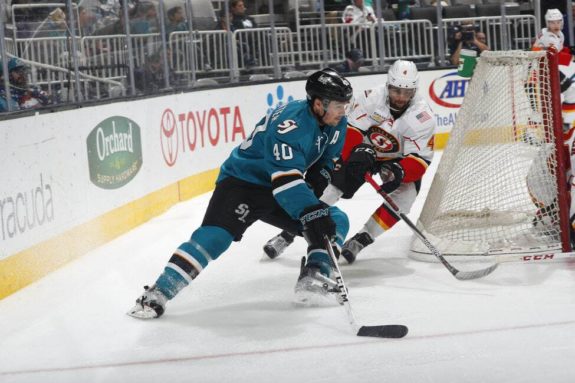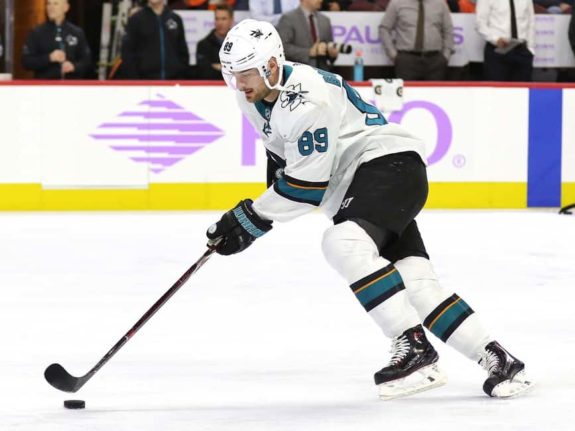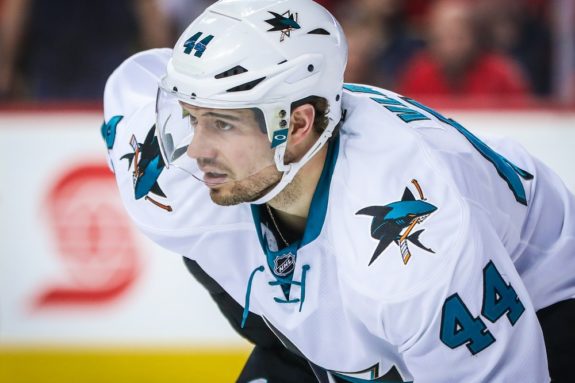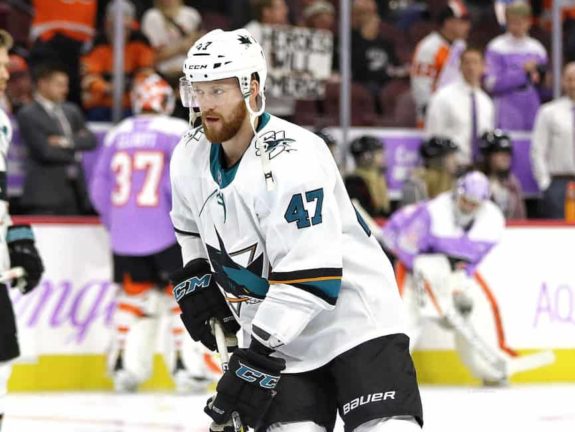Word came out over the weekend that San Jose Sharks defenseman Paul Martin was on the trade market. This was confirmed by general manager Doug Wilson and the trade inquiries were done at Martin’s request.
It isn’t hard to figure out why Martin is interested in a trade. He isn’t playing. He started off the season at less than full health, playing just two games before going onto injured reserve. While Martin has apparently returned to health, a spot in the Sharks line-up hasn’t opened up for him.
When no trade materialized over the weekend, the Sharks waived Martin. On Tuesday morning, Martin cleared waivers. It is expected he’ll wind up playing with the San Jose Barracuda, the Sharks AHL affiliate.
Paul Martin cleared waivers
— Pierre LeBrun (@PierreVLeBrun) January 16, 2018
Clearing waivers is about the best case scenario for both Martin and the Sharks. It is not surprising he cleared waivers. He turns 37 in less than two months and has been injured most of this season. His cap hit is $4.85 million and it runs through next season.
This is a lot of contract to take on for a player who, under the best of circumstances, probably isn’t worth it a this point in his career. Add in unknowns about his health and his current playing ability and its easy to see why there were no takers, either for trade or on waivers.
It makes sense for Martin to spend time in the AHL. He can work on getting back his game and his conditioning. Whether he remains on the trade block is a function of circumstances including his health, quality of play and the health of the Sharks other defensemen.
The Paul Martin Risk?
Martin holds one of a few challenging contracts for the San Jose Sharks, but his deal isn’t too bad. The Sharks have adequate cap room this season, so his cap hit isn’t an issue this season. They are likely to have cap space next year, even if Martin remains with the Sharks. And if the cap becomes an issue next season, the Sharks can buy out Martin or perhaps trade him.

Martin checks one important box for the Sharks. A box the team must seriously consider before agreeing to any trade. Martin is the partner who provided the best compliment to Brent Burns.
The Brent Burns Reward
For most of last season, Burns was the best player in hockey with Martin as his primary partner. Burns is having what amounts to a broken season without Martin.
The best possible thing the Sharks can do is fix Brent Burns — he sits at a minus-18.
Even in the past two games, where Burns is a plus-1, things haven’t been pretty. There have been three breakaways against the Sharks with Burns on the ice in the last two games. Fortunately, each breakaway was unsuccessful and the Sharks won both games. Of course, giving up breakaways is not a sustainable winning strategy.
If Martin works out well in the AHL, the Sharks owe it to the team to give Martin the chance to play with Burns and see if this fixes the best athlete on the team. The risk with Martin is tiny compared to the reward of Burns returning to form. The history says it’s worth a shot because the upside is enormous
Contract Challenges
The salary cap challenge posed by Paul Martin may be modest in isolation, but it isn’t in isolation. Indeed, the Sharks have a good cap situation now, and it is an asset they want to leverage. Perhaps they can leverage it this season, but more likely, it is something for next season and beyond.
Martin’s waiver is also part of a different numbers game. The Sharks have more healthy, NHL quality players than the NHL allows on a roster. Only a few Sharks can be demoted to the Barracuda without having to clear waivers. But these are players aren’t ones the team wants to demote.

The waiver process is why Ryan Carpenter is no longer part of the Sharks organization. The Sharks attempted to demote Carpenter, but he didn’t clear waivers and is now a member of the Vegas Golden Knights. I was surprised by the Carpenter move, there are other players the Sharks might lose on waivers who’d be missed less. These are the players with problematic contracts.
The Negative Value Deals
The Sharks have a few other deals they’d be happy to get out from under beyond Paul Martin. Two deals end this season. Joel Ward and Jannik Hansen combine for over $5 million of salary cap hit. Both have bounced around between the third line, the fourth line and healthy scratch. Trading Ward or Hansen only makes sense, however, if the Sharks are getting something back in return since their required cap space ends at the end of this season. Neither player will garner the Sharks much.
The contract the Sharks would like to dump the most belongs to Mikkel Boedker. Boedker has vastly underachieved his four-year, $16.0 million deal. Boedker’s contract runs through the 2019-20 season. Boedker and Martin have contracts which significantly exceed their contributions. In essence, they are negative value contracts.

While it usually makes logical sense to demote the player struggling the most, it might not be this way for San Jose — they might be best off demoting the poorest value. Demoting a player such as Boedker does not get rid of the salary cap responsibility, but it does avoid dropping a player who is a better value. And should Boedker get claimed, the Sharks would remove a player who simply hasn’t been a good fit for this team, which removes the salary cap responsibility for this season and beyond.
I’m surprised the Sharks didn’t make this move with Boedker when they demoted Carpenter.
Eight Defensemen
The Sharks have eight quality defensemen. Most teams need at least this many to get through a season. When all are healthy, I’d be tempted to keep all on the game day roster and only roster 13 forwards, one less than normal. I’d consider demoting Boedker, Hansen or Ward. These moves won’t save salary cap, but will save roster depth for this season.
Time on San Jose’s Side
The Sharks are looking for a top-tier player either via trade or free agency. They have the cap space to make it happen. The biggest salary they might take on is that of John Tavares, should they get him in free agency. They won’t need major roster surgery to make it happen. They might need to jettison either Boedker or Martin, but they have time to do this.
They have several million dollars in cap space now. Taking away the cap hits of Ward and Hansen plus adding in an expected $3 million of new cap space gives the Sharks a good bit of room for next season, even if some of this is offset by the new deals for goalie Martin Jones and defenseman Marc-Edouard Vlasic.

The big cap hit question for next season is Joe Thornton. Currently the highest paid Shark at $8 million, Thornton’s one-year deal ends after this season. Should the Sharks need Thornton to take a major pay cut (for one season) to add in a top-tier player such as Tavares, I sense this is workable. Thornton might have been the first player in league history to turn 38, have a major knee surgery, have his worst season in over 15 years … and get a raise of over $1 million.
The Sharks and Thornton have a strong relationship, and if San Jose gets substantially closer to a Stanley Cup via an acquisition, it is hard to imagine Thornton leaving town. It may look odd, but it wouldn’t be shocking to see Thornton go from $8 million this season to $4 million next and then to $6 million for another season, with each season being a one-year deal.
The Paul Martin Effect
Martin’s waiver helps highlight a pair of bigger stories. There are several contractual issues facing the San Jose Sharks. But careful examination shows these issues, while perhaps uncomfortable, are manageable. The issue which must be addressed, however, is fixing Brent Burns. If Paul Martin can contribute to this process, the Sharks will be thrilled he’s still with the team.
Zeke’s Notes
• The player keeping Paul Martin off the Sharks roster is Joakim Ryan. The rookie from Cornell is having a fine season. The Sharks repeated the Brenden Dillon-Brent Burns pairing and it hasn’t worked — again. Midway through the Saturday game against Arizona, the Sharks paired Ryan with Burns. The next game against the rival Kings (a 4-1 Sharks win), Ryan played a career high 23:11 of ice time.

Meanwhile, Dillon was reunited with Dylan DeMelo. Both finished the game plus-3 and DeMelo earned the second star. The spot opposite Burns is critical, but dropping Ryan to the Barracuda isn’t much of an option, even if he is among the few players who can get moved without going through waivers. Ryan is tied for the team lead in plus-minus.
• The standings are difficult to interpret this time of year, especially with the discrepancy in games played. The NHL points standings have the Sharks in ninth place. They fare considerably better in standings which don’t have a bias towards games played (the NHL is the only major professional league which does this).
With their win over the Los Angeles Kings on Monday, San Jose is much higher using other ranking methods (using either ‘points percentage’ or ‘games over even’ approaches). In the Western Conference, they trail only Vegas in the Pacific Division and Nashville and Winnipeg from the Central Division. Using the metrics applied in other professional sports leagues, San Jose is fourth in the Western Conference. Applying the “games behind” metric shows just how close the playoff chase is. There are four teams within one game of the Sharks and eight teams within three games. The playoff race in the Western Conference is insanely tight.